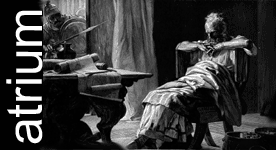JS sent this one in (thanks!) from the Cleveland Plain Dealer:
The world will have to wait a little longer before seeing and hearing the best evidence the Cleveland Museum of Art can present regarding the age and authorship of the large, ancient bronze sculpture of Apollo that it bought in 2004.
The museum is postponing a scholarly symposium on the sculpture, scheduled for October, because the work, attributed to the ancient Greek sculptor Praxiteles, will be borrowed by the Louvre Museum in Paris in the spring of 2007.
The Cleveland museum (www.clevelandart.org) wants to hold off on its symposium until after scholars from around the world have had a chance to see the sculpture in Paris.
"It's the right thing to do for the statue," said Michael Bennett, the Cleveland museum's curator of ancient Greek and Roman art. "It's our mission to share this with an international audience, and it's even better that this will help make a scholarly contribution in my field. It's exciting, and I'm really happy about it."
The museum now plans to hold its Apollo symposium late in 2008, when the institution reopens its Greek and Roman galleries as part of a $258 million expansion and renovation now under way.
The museum is entirely closed now and will reopen for special exhibitions this fall. Permanent-collection galleries will start reopening late in 2007 or early in 2008.
At the symposium, the museum will invite scholars from around the world to voice opinions on whether the Apollo Sauroktonos, or "Apollo the Lizard-Slayer," is an original by Praxiteles, a later version made in Greece or an even later Roman copy.
The closer the work is to Praxiteles, the more valuable it is, because large, ancient Greek bronzes are exceedingly rare, as are works connected to Praxiteles, a sculptor of legendary abilities.
The museum's sculpture, which stands 5 feet tall, is the only known large bronze version of the Apollo Sauroktonos. It is a version of a sculpture attributed by the ancient Roman writer Pliny the Elder to Praxiteles, which makes it the only large bronze linked to any Greek master by a literary reference.
But Bennett said, "It's not possible now to say that this statue was definitely made during Praxiteles' lifetime or the next generation or the next generation after that or indeed whether it was made in the [Greek] Hellenistic period or in the Roman period.
"What we're doing now is studying it carefully and trying to discover the facts about this particular work."
Archaeologists in America and England and Italian government officials have criticized the Cleveland museum for buying the Apollo, because the work has an incomplete provenance, or ownership history. The critics say such purchases encourage the looting of ancient sites.
Museum officials have said the public is better served by preserving, exhibiting and sharing the sculpture than by passing it up.
The Association of Art Museum Directors (www.aamd.org) announced last week that it will hold an international symposium at the New York Public Library on Thursday and Friday, May 4 and 5, on collecting antiquities, an increasingly controversial practice in the world of art.
